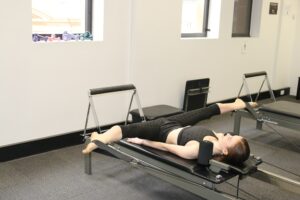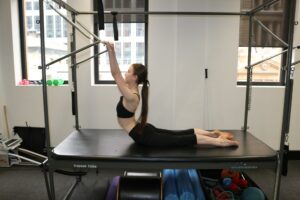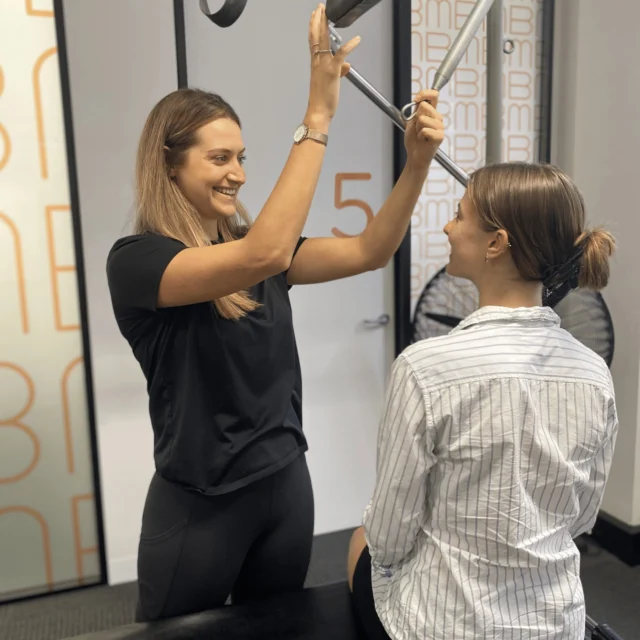Have you ever been told you have “floppy joints”?
The word HYPERMOBILITY is often used in a Physiotherapy consultation, but what does it really mean if you are hypermobile?
Most people have some degree of mobility in their joints, but when this movement is increased, and a joint moves beyond the normal range, it is termed hypermobility. Hypermobility is present in up to 15% of the population in one form or another. In many activities, like dancing, yoga and gymnastics, an increase in joint mobility is considered advantageous, especially as around 10% of the population who are hypermobile will not have any symptoms. However, others can experience symptoms, and this is when being “flexible” or “double-jointed” can become problematic. In these instances, hypermobility can cause an increase in joint pain, fatigue and an increased risk of injury. Hypermobility can exist at just one or two joints, within your peripherals or it may be widespread though out most joints. The condition commonly runs in families and many people exhibiting hypermobility have family members who are ‘flexible.’ Interestingly, joint hypermobility occurs three times more frequently in women than men.
When joint hypermobility is associated with symptoms it can be classified as HYPERMOBILITY SYNDROME (HMS). Hypermobility syndrome encompasses individuals who have hypermobility related problems but do not have a Heritable Disorder of Connective tissue. Hypermobility can also be classified based on the presence of an underlying Heritable Disorder of Connective Tissue such as Ehler’s Danlos Syndrome and Marfan’s Syndrome, just to name a couple. I will further discuss how both syndromes present at a later point in this article.
Some of the most common symptoms of hypermobility include:
- Frequent subluxations or dislocations
- Chronic pain
- Neural tissue pain (eg. pins and needles)
- Gut issues (eg. IBS)
- Autonomic dysfunction (eg. POTS)

- Anxiety
- Fatigue
- General deconditioning
- Excessive bruising
- Disrupted sleep
- Headaches / dizziness
- Pelvic floor concerns or prolapse
Some other factors that can contribute to hypermobile joints are:
- Strength/muscle tone- weaker, or more relaxed muscles allow for a greater range of movement.
- Bone shape/Joint socket depth- shallow joint sockets, allow a greater range of movement than is considered normal.
- Poor proprioception (ability to sense movement)- you may struggle to sense how far you stretch your body, leading to hyperflexion.
What is the difference between being flexible and hypermobility?
Flexibility refers to the ability to lengthen muscles, hypermobility refers to a laxity in the ligaments surrounding the joints. In other words, you can gain flexibility through consistent stretching techniques, but you cannot stretch ligaments to increase joint mobility.
How do you know if you are hypermobile?
There are two screening tools that are commonly used to look for generalised hypermobility: The five-part questionnaire and the Beighton score.
To answer the five-part questionnaire below it is good to start by thinking back to when you were a teenager. Our joints tend to stiffen as we get older and therefore, they do not give a good representation of the underlying mobility.
- Can you now (or could you ever) place your hands flat on the floor without bending your knees?
- Can you now (or could you ever) bend your thumb to touch your forearm?
- As a child did you amuse your friends by contorting your body into strange shapes or could you do the splits?
- As a child or teenager did your shoulder or kneecap dislocate on more than one occasion?
- Do you consider yourself double-jointed?
If you answered ‘Yes’ to 2 or more of the above questions, there is a high likelihood that you have joint hypermobility.
Your Physiotherapist will run you through the Beighton’s score which looks at the range of motion of your fingers, thumb, elbows, back and knees through a series of manoeuvres.
How can Physiotherapy help?
Physiotherapy can be greatly beneficial for people with hypermobility related pain in both reducing symptoms and prescribing an appropriate exercise program designed to ensure that the joints are well supported by the surrounding musculature. Physiotherapy combined with Physio-led Pilates is often found to be the treatment of choice for these conditions.
What will your Physiotherapist do for hypermobility?
- Complete a formal assessment using the Beighton’s Score which determines the presence or absence of hypermobility.
- Provide you with education regarding normal joint ranges and how to prevent an unstable joint by avoiding extreme joint ranges.
- Provision of active mobilisation exercises which can reduce strain on injured ligaments, augment proprioceptive feedback and optimise muscle action.
- Provision of strengthening exercises which can stabilise muscles around hypermobile joints which is effective for joint support and reducing pain.
- Provision of proprioceptive exercises as a decrease in joint position sense will make you more vulnerable to damage. These may include balance and co-ordination exercises.
- Control neutral joint position by identifying the abnormal resting position of symptomatic joints and retraining postural muscles to facilitate optimal joint alignment.
- Retrain dynamic control involving retraining of specific muscles to maintain joint position while moving adjacent joints.
- Motion control which includes improving the ability of specific muscles to control the joint through its entire range, both concentrically and eccentrically, static and posture.
How can Pilates be beneficial for hypermobility?
Because of the increased range of motion in the joints, hypermobile individual needs to have sufficient strength for their whole range of motion. Pilates works to increase stability, muscular strength, and endurance – all of which are particularly important for hypermobility.
Another function of Pilates is to increase proprioception, which is essentially body awareness, involving special awareness, co-ordination, and balance. Hypermobile people can have difficulty knowing where their body is in space, simply because they have a larger range of movement than others. Pilates focuses on building this awareness and can have a significant impact on enhancing our proprioception and improving internal stability.
Now getting back to both Ehlers Danlos syndrome and Marfan’s syndrome. Hypermobility is normally idiopathic in nature, but it can be a warning sign of a range of underlying diseases. One of these diseases is a lesser-known condition called Ehlers Danlos syndrome, a genetic condition which is inherited from birth.
Ehlers Danlos syndrome can affect the tendons, muscles, ligaments, skin, lungs, blood vessels, lenses of the eye and the heart valves in an affected person. The extent to which body system is affected, depends on the type of Ehlers Danlos you are suffering from. There are 13 different types that are currently known about and include classical Ehlers Danlos which is characterised by bruising, scarring and hypermobility, vascular which is characterised by arterial ruptures and hypermobile Ehlers Danlos which is characterised by joint dislocations and skin hyperextensibility. The way in which this condition and the subtypes are diagnosed are based on a set of defined diagnostic criteria and a genetic test.
Ehlers Danlos syndrome affects the collagen which makes up the joints and ligaments of our body. There are a few different types of collagen that exist normally within our body with each collagen being represented by a certain gene or genetic marker. When the collagen is disrupted or not formed correctly it can affect the areas of our body which are made of collagen such as the blood vessels, skin and ligaments
The way in which Ehlers Danlos differs from pure hypermobility is usually due to the associated symptoms. It is thought people with Ehlers Danlos experience symptoms of fatigue and joint pain in addition to the hypermobility and skin extensibility that people with pure hypermobility have. People with Ehlers Danlos also have a range of other systemic symptom’s that may be absent in someone with hypermobility.
The treatment for Ehlers Danlos heavily depends on type of Ehlers Danlos that you have and the symptoms that you have. For the types in which hypermobility and extensibility are the main symptoms it is important to strengthen your joints and muscles in an appropriate way and limit the stretching of your joints and muscles. Supervised exercise programs with a physiotherapist can be a good way of managing this. There is also a range of medications available for pain relief and medical management and monitoring is a necessity.
Marfan syndrome is a genetic disorder of the connective tissue affecting most notably the skeletal system, cardiovascular system, eyes, and skin, among other body systems. Due to the widespread role of connective tissue throughout the body, individuals with Marfan syndrome may be at risk for many potentially severe or lethal co-morbidities because of the disease process. Marfan syndrome is inherited through an autosomal dominant mutation of the gene encoding glycoprotein fibrillin-1 (FBN1), which plays a role in the anchoring of cells to the extra-cellular matrix and is the main component of microfibrils. Microfibrils affect the strength and elasticity of connective tissue and control the release of growth factors that cause growth and repair of tissues and organs throughout the body. A defect in this gene means that the quality and/or quantity of fibrillin-1 in the body is decreased, reducing the amount available to form microfibrils, implicating changes in the body’s connective tissues and growth of tissues. Marfan’s most widely known physical characteristics include a tall, thin build with long fingers, arms, and legs.
People with Marfan syndrome can display any or all the following physical characteristics:
- Tall, thin body build
- Long arms and legs
- Elongated fingers and toes
- Unusually flexible joints
- Long narrow face
- Highly arched roof of the mouth
- Crowded teeth
- Small lower jaw
- Scoliosis (S shaped curvature of the spine)
- Pes planus (flat feet or fallen arches), Pectus excavatum (where the breastbone sinks into the chest), Pectus carinatum (where breastbone and ribs are pushed outward from chest)
- Arm span that exceeds body height.
Because patients with Marfan syndrome have different clinical manifestations, physiotherapy may be helpful to the individuals who experience problems from the musculoskeletal issues that are often associated with Marfan syndrome. This includes but is not limited to pes planus, scoliosis, and pectus excavatum and pectus carinatum and the physical issues they may cause. Stretching, strengthening, therapeutic exercises, modalities for pain, fabricating or recommending orthotics, as well as patient education are all valuable tools the physical therapist can use in the management of the patient with Marfan syndrome. Physical therapists can also play a role in advising the patient with Marfan syndrome on the risks and benefits of exercise and participation in sports. Specifically, the patient should be educated on the risk to the cardiovascular system with strenuous and contact sports and should be advised on the National Marfan Foundation’s Physical Activity Guidelines, prepared by the NMF Professional Advisory Board.
If you are concerned that hypermobility is impacting you and would like to see how Physiotherapy and Pilates can be beneficial for you, book in at Bend + Mend for an assessment with one of our experienced Physiotherapists.






